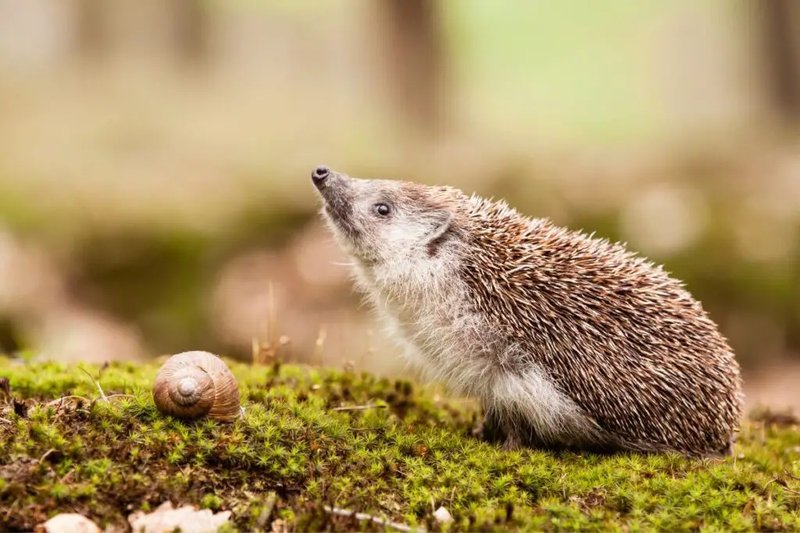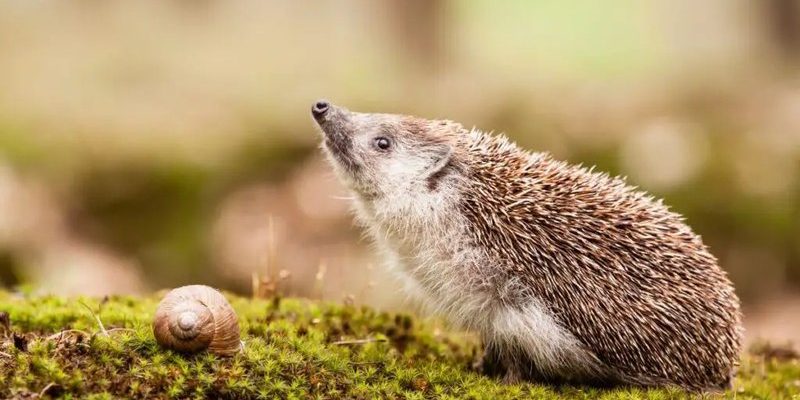
In this article, I’m going to introduce you to ten other animals that resemble porcupines in one way or another. We’ll explore their similarities and, more importantly, what makes them different. This way, the next time you see one of these creatures in a book or out in the wild, you’ll be able to swoop in with some fun facts and impress your friends!
1. Hedgehog
Hedgehogs might be the first animals that come to mind when you think about creatures with spines. These little guys are covered in sharp quills, just like porcupines. However, there’s a world of difference between them. Hedgehogs are much smaller and have a more rounded shape. Their quills are not as long or thick, and they don’t use them for defense in the same way that porcupines do.
Instead, when faced with danger, hedgehogs roll into a tight ball, using their quills as a protective shield. Imagine curling up with a cozy blanket—only the blanket is made of spikes! Another notable difference is their diet. Hedgehogs are insectivores, munching on things like snails and worms, while porcupines primarily eat plant material, including leaves and bark.
2. Echidna
Echidnas, often referred to as spiny anteaters, are another unique animal that shares a few traits with porcupines. Like porcupines, echidnas are covered in spines, but they also have a long snout that they use to hunt for ants and termites. Think of them as the ultimate insect hunters!
One striking feature that sets echidnas apart is their ability to lay eggs, which is pretty rare among mammals. While porcupines give birth to live young, echidnas are part of a small group called monotremes, which includes platypuses. If you ever come across an echidna, you’ll notice they have a more elongated body and a less bushy appearance compared to porcupines, making them look quite different when you really observe them.
3. Sea Urchin
Okay, hear me out: sea urchins and porcupines may not seem similar at first glance, but they do have one thing in common—spikes! Sea urchins are marine animals adorned with sharp spines, providing them with protection against predators. However, they live underwater and have a much different lifestyle.
While porcupines scuttle around in forests, sea urchins cling to rocks on the ocean floor. They have a hard shell and feed mainly on algae. So, if you’re ever diving and spot a sea urchin, just remember they’re a bit like porcupines of the sea, albeit without the cuddly charm that porcupines have on land!
4. Armadillo
Armadillos might not have quills, but they do have a tough, armored shell that offers them protection, similar to how a porcupine’s quills act as a defense mechanism. Armadillos can roll into a ball, much like hedgehogs, but their armor is made of bony plates instead of spines.
These creatures are primarily found in the Americas and are known for their digging skills, often using their claws to burrow into the ground. While porcupines mainly stay above ground, armadillos are the underground ninjas of the animal kingdom, feasting on insects, grubs, and even plants.
5. Aardvark
Aardvarks are another fascinating creature that might remind you of a porcupine. While they don’t have spines, they share an unusual look and a nocturnal lifestyle. Their long ears and snout give them a rather unique appearance, and like porcupines, they also have a love for insects—especially ants and termites.
Aardvarks are native to Africa and are great diggers, using their strong claws to find food underground. They have a more streamlined body compared to porcupines, but their burrowing habits and food preferences make them somewhat kindred spirits in the animal kingdom.
6. Capybara
You might be surprised to find capybaras on this list, but bear with me! While they don’t have any spikes, capybaras, the world’s largest rodents, do share a similar habitat with porcupines. They love being around water and are semi-aquatic, often found near rivers and ponds.
Capybaras are social animals that live in groups, unlike the more solitary porcupine. They also have a friendly demeanor and can often be found lounging in the sun or swimming. While their looks are quite different, both animals play significant roles in their respective ecosystems.
7. Porcupette
Okay, so a *porcupette* is not really a different animal, but it’s worth mentioning! Porcupettes are the adorable baby porcupines that come into the world with soft quills that harden over time. They are small, fluffy, and undeniably cute, often seen clinging to their mother’s back.
This little fact adds a wonderful twist to the porcupine story. When thinking about porcupines and their relatives, remember that they also have their own young that face the world similarly—maybe not with as many quills at first, but they sure grow into them!
8. Quokka
You might be wondering how a quokka fits into this line-up. Quokkas are small marsupials from Australia, often nicknamed “the world’s happiest animal” because of their adorable faces. While they don’t have spines, they do share a herbivorous diet with porcupines.
Quokkas are social and friendly, and they love munching on grass and leaves, similar to how porcupines enjoy plant material. They might be the furriest cousins to the porcupine family, offering a bright and cheerful contrast to the spiky critters we often think of.
9. Cavy
Cavies, which includes guinea pigs, are yet another group that shares some traits with porcupines. They are social rodents with a stocky build and a love for grazing on plants. While they don’t have quills, their round bodies and herbivorous diet bring them a bit closer to our spiky friends.
Cavies are often kept as pets, making them familiar to many. Their affectionate nature makes them a delightful addition to households, while porcupines remain wild and somewhat elusive.
10. Pygmy Hedgehog
Last but not least, let’s touch on the pygmy hedgehog. These smaller cousins of the common hedgehog exhibit similar traits while being even cuter—if that’s possible! They share the same nifty ball-rolling defense mechanism and, like porcupines, have a spiny coat.
Pygmy hedgehogs have become popular pets, bringing a little of that porcupine charm into homes. Both animals play crucial roles in their ecosystems, controlling insect populations while being just plain adorable.
So, there you have it! Ten animals that share some surprising similarities with the porcupine. From the armor-clad armadillo to the cuddly porcupette, each of these animals brings something unique to the table, even if they share a few features. Whether you’re hiking in the woods or scrolling through pictures online, now you’ll have a better idea of how to recognize and appreciate these fascinating creatures.
Remember, every animal has its place in nature, and getting to know them better helps us understand the world we share. Who knows—maybe next time you see a porcupine, you’ll also think about its quirky relatives and the wonderful diversity of life all around us!

